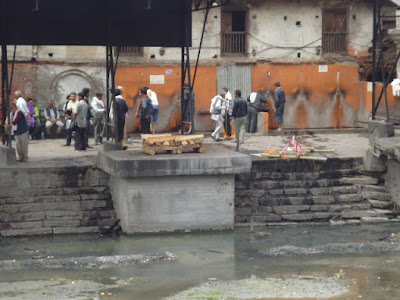We hosted a medical team from the USA. For one of their cultural experiences we went to the Pashupathinath Temple complex. The temple is also called Pashupati by locals. The temple is one of the most sacred Hindu sites in Nepal. The first temple built on this site is believed to have been constructed in 753 AD.
This Hindu priest is sitting in a small shrine. The shrine had the blood of sacrificial sheep in and around. Our guide said that the animals were sacrificed and then the priest conferred a blessing on those worshiping at the temple.
This animal is tied up next the small temple with the priest. It is waiting to be sacrificed.
One of the purposes of Pashupati is to provide funeral services for the Hindu faithful. They can either be cremated outdoors on the banks of the Bagmati river or indoors in a modern facility. This picture shows a funeral pyre being prepared on the river.
While we were at the temple site a funeral was being conducted. The funeral appeared to be for a high ranking military person. There were a lot of military people present. There were a large number of people both military and civilian.
The two pictures above show sadhu or holy men. Sadhu have left behind all material possessions and live in forests, caves and at temples throughout Nepal and India. The Sadhu is dedicated to achieving moksa which is the fourth and final stage of life through meditation. Our guide told us that only people from India could be holy men. Because they are Indian and not Nepali some people are suspicious of them. These Sadhu did request that we pay an alm of 100 rupies (about a dollar) for taking a picture.
Near the top of the temple complex hill is a line of small shrines. Our guide said that people come to the shrines seeking prosperity and fertility.
On each of the small shrines is carving of the goddess Manasa or Mansa Devi. She is worshiped for the cure and prevention of snake bite, fertility and prosperity.









No comments:
Post a Comment